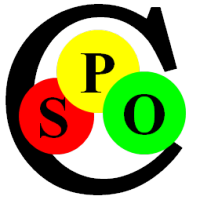Wir use Models everyday without worrying too much. We ponder Alternatives by playing/simulating them in our mental Modells. We "know" our Environment and plan our Actions without being aware of the Structures facilitating this.
In this Section we want to present the Key Ideas of the semantic Web and Knowledge-Management. We will demonstrate that this is no Secret, because we are unconsciuously using the Techniques since we were born.
Our Journey will take us through several Layers of Knowledge, each at a higher Level. But rest assured, we advance in small Steps and each is easy to master. It just takes some Examples to get the Idea and Practice to gain Confidence in using the Concepts.
Level One: Individuals
The first Level is intuitively accessible. It deals with individual Things and Values, mostly of well known Objects of daily Life.
-
Things: These are concrete or also abstract Things surrounding us everyday: People, Places, Events etc.
We give them more or less unique Names, to easily find them. We add Text or Pictures ergänzen, to rapidly recognize and easily remember them. We add Descriptions to transfer Knowledge. - Connections: On the next Level we connect these Things to describe the Relationships among them. This conveys Knowledge about the Structures. It also help us finding them when we work in its Proximity. This is important in complex Environments where You need to be aware of the many Implications an Action may have. Connections have a Direction, Color, a Weight (indicated by their witdth) and can be annotated with a Label to describe their Nature.
-
Properties: As we capture more Facts, the simple textual Description soon becomes unwieldy. We need to record Properties in a structured Manner, collecting Pairs of Names and
Values like
"First Name" = "Peter"
"Weight" = 85,
"Birthday" = 1968-04-11.
This enables us to break pure textual Descriptions into crisp, manageable Facts. But we need more:
Level Two: Collections
This Level deals with Collections of Things. This gives us the Power to handle large Sets of Objects. The Key to this Level is recognizing Similarities. Similarities lead to Abstractions that simplify handling Masses of Data.
- Predicates: We soon realize, that simple Property Names are nice for ad hoc Note-Taking, but do not help in working with large Sets of Data. We want to find Things in Collections by their Properties and Values, something that is still not possible on the Internet! Consistency is needed here: Only when we re-use the same Property Names or, even better, use Predicates, we can handle large Sets. Predicates are well-known, standardized Property Types with a defined Meaning. Examples are: "Weight(kg)", a Property used only for physical Things to note their Weight in Kilograms. Now You can search through the whole Database for Things that are e.g. lighter than 80 kg.
-
Classes: We usually group Things of the same Kind and give this abstract Set a Name. These Groups are called "Classes" and are usually characterized as Collections of Objects
having similar Properties and Connections. Common Examples are "Animals", "Buildings", "Thoughts", but also higher level Classes like "Classes". You want to use these Classes to search for
Things of a certain Kind, e.g. "People" or "Cars" etc., something that is also not commonly possible on the Internet. We name Classes in Plural to distinguish it from specific concrete
Examples (also known as "Instances") of this Class.
- The last Example "Classes" is in fact already very advanced, but You are in good Company: Up to the second Half of the last Century even the best Theorists had Problems with Classes like that. But with some Experience You will get Confidence even in handling such Cases.
- Relations: To better navigate through large and dense Networks of Things, simple Connections are not good enough! Reading though the Labels takes too much time. Instead you need something similar to Predicates: typed Connections, so-called "Relations". These have a well-defined Nature and Meaning. You can use them to filter the Connections in the displayed Networks and gain high-Level Overview in dense Situations. You can also search for Things by specifying the Type and Weight of their Relation to other Things!
Level Three: Tables
- Tables: When handling many Things of the same Class, Tables give You much more Overview than just looking at each one individually. Spoc-Web supports creating and modifying Tables. This powerful Feature has many Benefits:
- It supports You and others in capturing Data by providing a Scheme with a core Set of Properties and Relationships to fill in.
- It displays Properties and Relationships in Columns, so You can quickly compare Items by different Criteria.
- It allows to sort and filter Items by their Properties or Relationships
- You can specify Constraints that are checked on entering or changing Data
Further Reading:
There is much more to know about Tables, but now it is time to recapture the Concepts listed above and dive deeper into them by following these Links:




